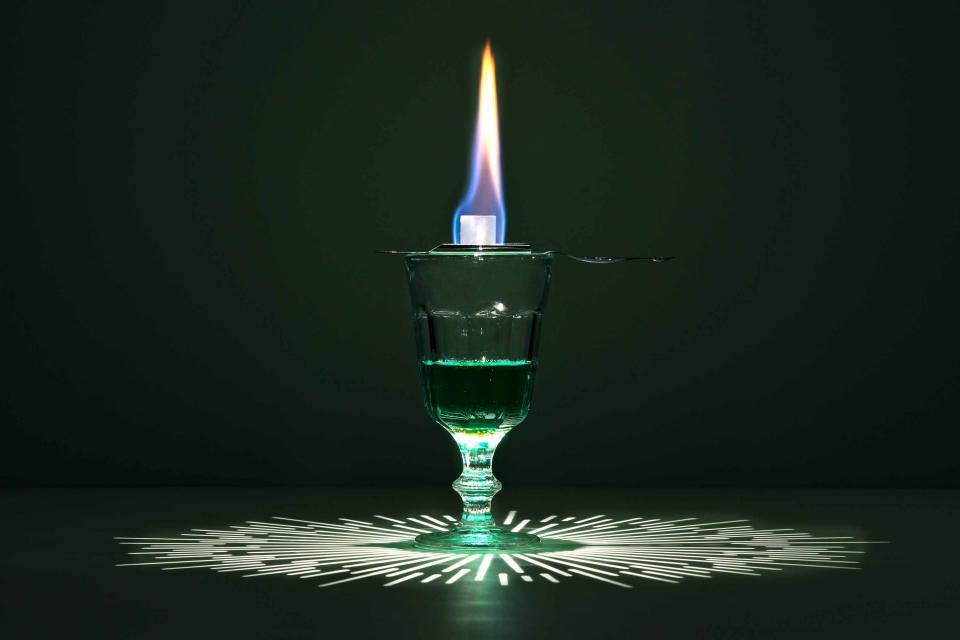Absinthe Explained: Everything You Want to Know
No, it won't make your hallucinate. Yes, it is delicious.

There is no spirit whose history is more steeped in misconception than absinthe. Throughout its lengthy history, the light green liquor has been blamed for a slew of bad behavior from silly drunkenness to murder — yes, murder. In spite of the dangerous discourse, this potent but delicious spirit is well overdue for a serious debunking, and a spot on your home bar.
What Is Absinthe?
Absinthe is an overproof liquor, meaning it is a spirit whose ABV (alcohol by volume) is over 50%. It is made from medicinal and culinary herbs, plants, and flowers steeped in high-proof spirits. "The elixir was invented in Switzerland as a general cure-all by Pierre Ordinaire, a French physician, in 1792," writes Paul Harrington and Laura Moorhead in their book Cocktail: The Drinks Bible for the 21st Century. Its signature bitter anise flavor comes from a mix of herbs including fennel and most notably, wormwood, a bitter herb notorious for both its health benefits and supposed hallucinogenic properties. Wormwood, or Artemisia absinthium, contains a chemical called thujone, which when consumed in large quantities can act as a convulsant. In small quantities, like in a few servings of absinthe, thujone is totally harmless. Traditionally, absinthe is not bottled with added sugar, making it a high-proof spirit instead of a sweetened liqueur,which gives absinthe its sharp, harsh flavor.
How to Drink Absinthe
Absinthe's botanical notes bring a delicious and distinctive flavor to any cocktail in which it's used, but there are a few traditional ways of enjoying it that really show off its unique qualities. Nicolas O'Connor, Beverage Director of NYC's Apotheke NoMad, is such a fan of absinthe that he curated a dedicated list to the spirit, and includes it in multiple of the bar's most inventive cocktails. Despite its versatility in mixed drinks, O'Connor says he enjoys sipping absinthe in the Parisian style, also known as the absinthe drip, in which a sugar cube is placed on a flat slotted spoon that is balanced over the glass of absinthe. Cold water is poured over the sugar cube, leading it to slowly dissolve into the absinthe in a process called louching, where a high-proof spirit thickens slightly and turns cloudy with the addition of water. "Adding sugar and water to absinthe brings out the botanical and sweet notes while making the very high-proof liquor easier to consume," says O'Connor. "I find most people can't handle absinthe at its full strength [due to its high proof], but really enjoy the flavor profile once it's been diluted down."
Meanwhile, O'Connor's Devil's Playground cocktail pairs absinthe's herbaceous flavors with sweet notes like prickly pear and dragon fruit. "My favorite use for absinthe is as a modifier in cocktails incorporating fresh botanicals and citrus," he explains. "Absinthe has such a bold and viscous taste and when it's used in small amounts, it can cut through an already busy palate."
If you're enjoying absinthe at home instead of at a bar, transfer absinthe into a mister or small dropper for faint amounts of the potent spirit as you experiment with cocktails. "By presenting absinthe for its flavor and not its strength, you can show people it can be a versatile part of any liquor cabinet," he says.
Is Absinthe Legal?
The height of consumption for absinthe was in the late 19th century when it was used both as an antimalarial aid, and enjoyed as an alcoholic beverage. Absinthe was banned in many countries in the early 20th century. In Europe, absinthe bans were largely due to an unlikely convergence of lobbying efforts: the rising temperance movement who linked the dangers of absinthe to social and economic unrest, and the wine business who saw a drop in sales with the rise of absinthe consumption. Under the influence of lobbyists, many European governments banned absinthe in the early 1900s, with pockets of legality allowing some countries to continue distilling it. In the United States, absinthe found its deepest roots in New Orleans, where it was popularized in iconic cocktails like the Sazerac.
Where to Buy Absinthe
Pernod, one of the ingredients in the Sazerac, is an excellent place to start if you're just dipping your toes into the world of absinthe. The anise-flavored spirit was originally distilled by Henri-Louis Pernod, and became the first commercial absinthe on the international market. Today, the spirit is largely available throughout the United States; American-made St. George spirits is reviving absinthe distilling with carefully crafted blends of botanicals.
Absinthe in Art
The 110-proof spirit (that's 55% ABV!) derives its light green hue naturally from green anise and other herbs — beware bright green absinthe, which may involve artificial dyes. Absinthe's color is part of its mystical lure; Known as "The Green Fairy," or La Fée Verte in French, absinthe was both an intoxicant and a muse for Impressionist painters. In fact, some of the most iconic European art from the mid-1800s is soaked in absinthe, as evidenced in the work of painters like Edgar Degas, Pablo Picasso, Claude Manet, Vincent Van Gough, and Henri Toulouse-Lautrec. In French impressionist art, absinthe is depicted in paintings both directly and indirectly; see glasses of light green absinthe being enjoyed in portraits of bar-goers, or look for faint green hues used to color fairies or spirits in the background of paintings. These impressionist painters, as well as modernist authors like Ernest Hemingway, are said to have leaned into the wild, hallucinogenic properties of absinthe to fuel their creative art and writing. Little did they know, though, that they were not hallucinating from wormwood, but rather just wildly drunk from the over-consumption of high-proof liquor.

